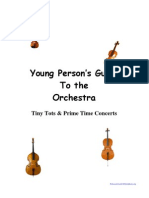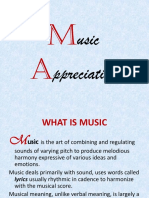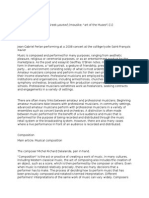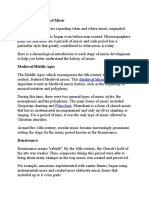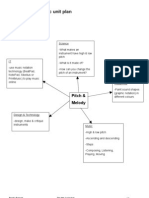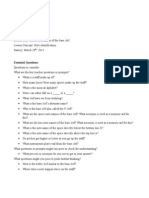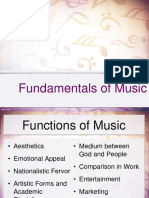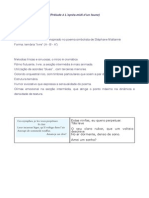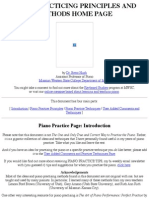Introduction To Music
Introduction To Music
Uploaded by
fredlopez09Copyright:
Available Formats
Introduction To Music
Introduction To Music
Uploaded by
fredlopez09Original Description:
Original Title
Copyright
Available Formats
Share this document
Did you find this document useful?
Is this content inappropriate?
Copyright:
Available Formats
Introduction To Music
Introduction To Music
Uploaded by
fredlopez09Copyright:
Available Formats
Introduction to music[edit] What is music?
Even before recorded history, people created music, whether through drumming, singing or chanting. Some of our strongest emotions may be brought on by listening to a piece of music. In this modern age, we hear music around us almost all of our waking hours, in one form or another: radio, television or film music and our personal music (iPods, MP3 players, etc.) is with us throughout the day. Most of us listen to recorded music or go to performances regularly, and some of us play a musical instrument. Prior to modern audio recording technology, music was available only in the presence of a musician, or to those who played an instrument or sang. Musical concepts[edit] A basic definition of music (in the Western World) is the chronological organisation of sounds; that is, making certain sounds at certain times, which make melodic, rhythmic and harmonic sense. The first, most basic concept, is keeping the sounds "in time". This leads us to some of the first few musical concepts: beat, rhythm and duration. Beat is the regular pulse which provides a `timeline` for the rhythm to anchor itself to. Rhythm is essentially repeated patterns of long or short, stressed or unstressed sounds or silences which fit into the main beat. Duration is the length of notes or sounds or silences which facilitate the rhythm.
Music is also the relationship between sound and silence. Duration and rhythm apply to silence in the same manner as they apply to sound. One way to look at how we perceive music is as horizontal and vertical patterns. We hear melodies as a horizontal pattern. The notes (and silences) are heard one after the other over a period of time. We hear chords (groups of notes played simultaneously) in a vertical pattern. A mixture of one or all of these: melody, rhythm, chords, and silence form musical patterns. Rhythm[edit] Rhythm is the most basic concept of music. In all cultures worldwide, the most simple and basic forms of music are purely rhythms. A rhythm is a pulse; a repetition of sounds in a pattern. Simple rhythms can be recognized straight away. Tapping rhythmically at a drum constitutes tapping it at timed intervals in a pattern. The most common rhythmic pattern in modern-day Western music is time (say four-four time). This is where four pulses come one after the other, with the first of each four being given emphasis (known as an accent). Try this exercise: Say the words "one, two, three, four, one, two, three, four..." etc. continuously, and at even time intervals.
Now each time you say "one", say it slightly louder: "one, two, three, four, one, two, three, four..." etc. You have just been saying the words "one", "two", "three" and "four" in time. Reading[edit] Rhythm module at Wikibooks. rhythm article at Wikipedia Tutorials[edit] Mad Max - Creating more sounds with rhythm using GarageBand and symphony orchestra sounds - part of Filmmaking. Melody[edit] In music, pitch is used to describe how high or low a note sounds. Anyone would know the difference between a high-pitched scratching of fingernails across a blackboard, and the low, rumbling growl of thunder. When Maria tells the children in The Sound of Music that "the first few notes just happen to be...do re mi", she was referring to pitch. Using pitch, together with rhythm, we can start to construct melodies. Without rhythm, notes would just be long, sustained sounds. Without pitch, each sound would be the same (for example, the beating of a single drum). Dynamics[edit] In music, we use the word dynamics to describe how loudly or softly a note is played. Dynamics falls under the wider category of expressive techniques, which are instructions for the performer to play loudly or softly, smoothly or detached, and many other effects. Timbre (tone colour)[edit] In music, the "colour" of a sound being produced is referred to as timbre, or tone colour. Timbre is the difference between the harsh, scratchy sound of an electric guitar with distortion; the glassy, rounded sound of a piano; and the bird-like whispering sound of a flute. All these instruments could play exactly the same note, yet anyone would be able to recognise instantly an electric guitar from a piano from a flute. Structure[edit] Musical structure is usually defined by several things including scales and/or arpeggios , rhythm, key signature, melodic patterns, variations Etc. To keep this particular paragraph concise, all or some of the elements of music theory can be used in the structure of a musical piece. Many composers that listen to Bach are fascinated by the palindromes, variations and inversions of patterns contained in its compositional structure, most of which will never be noticed unless you plan on going through the notation with a magnifying glass.
--Subnote, Colhsh: Musical Structure also refers to the overall layout of a musical work as a whole, these come in several forms the simplest form is Binary form, in which there is one section of music "A" which is then juxtaposed against a contrasting "B" section which finishes it, giving the piece an "A-B" structure. An expansion on this is ternary form which is the same as binary, except that the "A" section is repeated, making the overall structure "A-B-A" Another musical form that was popular during the classical era is that of the Rondo form, in which there is an "A" section that is repeated throughout the work, but is interrupted by contrasting episodes, making any work in a random form typically have the structure of "A-B-A-C-A-D-Etc." Larger structures include "Sonata form," which was developed in the Classical Period. The "Sonata form" often is the structure of the first movement of a Sonata, Symphony, and Concerto. The Sonata form is comprised of four sections. Exposition - Introduces a main theme in the tonic key, and a subordinate theme in a related key - often the dominant, or if in a minor key - the relative major. Development - Develops and elaborates the themes and explores new and exciting key centers. Recapitulation - Returns to the tonic key and states the main theme and subordinate theme. The subordinate theme is often reworked to stay in the tonic. Coda - Concludes the piece. Texture[edit] Texture refers to the layering of sounds on top of each other. It describes the depth, nature, and relationship of those layers of sound, or voices. It can describe the vertical and horizontal relationship between the voices. Some common textures are: Monophonic texture: A melody by itself, without harmony, and without another melody. For example, singing in the shower, monks chanting, or a fife and drum corps. Polyphonic texture: Two or more melodies, heard at the same time. For example, singing "Row, row, row your boat" as a round, or a Bach Fugue. Homophonic texture: A melody accompanied by harmony, or by less important melodies. Most popular music is homophonic, and much classical music as well, such as Beethoven's "Moonlight" Sonata, or a church hymn. Mixed texture: More than one musical texture. For example, singing a round (polyphony) accompanied by guitar chords (homophony). Texture can also be described with such terms as thick, dense, or open.
You might also like
- MU9CL IIb G 5Document3 pagesMU9CL IIb G 5ArvinNo ratings yet
- Sing, Sketch and Stay HealthyDocument35 pagesSing, Sketch and Stay HealthyJOSEPHINE CASINNo ratings yet
- Young Person Guia Benjamin BritenDocument34 pagesYoung Person Guia Benjamin Britenedmundo230468No ratings yet
- Baroque Music Grade 9Document31 pagesBaroque Music Grade 9Angel Lizette B. Batioco100% (1)
- Music Lessons Yr 2 & 4Document9 pagesMusic Lessons Yr 2 & 4Kim Louise Hartley100% (2)
- Music AppreciationDocument22 pagesMusic AppreciationChristian Dela Pena100% (1)
- MUSICDocument21 pagesMUSICSyrill PortugalNo ratings yet
- in Music FinalDocument86 pagesin Music FinalDaniella Timbol0% (1)
- Etymology of MusicDocument6 pagesEtymology of MusicVanessa MerendaNo ratings yet
- Elements of MusicDocument9 pagesElements of MusicJoshua De Leon TuasonNo ratings yet
- Lesson 1 Medieval PeriodDocument10 pagesLesson 1 Medieval PeriodJonh Edwel AllocNo ratings yet
- Music DynamicsDocument2 pagesMusic DynamicsStefan Manevski100% (1)
- Music of The Medieval PeriodDocument33 pagesMusic of The Medieval PeriodEric Jordan ManuevoNo ratings yet
- Classical Music: Characteristics Musical Styles Classical ComposersDocument31 pagesClassical Music: Characteristics Musical Styles Classical ComposersAnson AtilanoNo ratings yet
- History of MusicDocument58 pagesHistory of Musicguysarkis100% (2)
- Traditional MusicDocument22 pagesTraditional MusicAlfred Harvey ElacionNo ratings yet
- How Micro Lessons Affect Music Classes in Chinese SchoolsDocument13 pagesHow Micro Lessons Affect Music Classes in Chinese SchoolsPurity Angwenyi100% (1)
- Music of The Classical PeriodDocument4 pagesMusic of The Classical Periodmcheche12No ratings yet
- Unit 7: Musical Form: Index: 1. Some Musical Forms 2. Musical Form in Popular MusicDocument8 pagesUnit 7: Musical Form: Index: 1. Some Musical Forms 2. Musical Form in Popular MusicieslasencinasmusicaNo ratings yet
- Music in Renaissance PeriodDocument26 pagesMusic in Renaissance PeriodHezil Mae Mancao0% (1)
- Music of KoreaDocument14 pagesMusic of KoreaDarwinn DonqueNo ratings yet
- Baroque PeriodDocument13 pagesBaroque PeriodGarutay AsinNo ratings yet
- MyanmarDocument9 pagesMyanmarReiner100% (1)
- Handout Music 9Document3 pagesHandout Music 9Sayu QT100% (1)
- History of MusicDocument3 pagesHistory of MusicSam GeorgeNo ratings yet
- K To 12 Curriculum Guide MUSIC Grade 1 TDocument139 pagesK To 12 Curriculum Guide MUSIC Grade 1 TRhiane Stanford100% (1)
- Music - PITCH Unit Plan Year 4/5Document38 pagesMusic - PITCH Unit Plan Year 4/5mbed2010100% (2)
- MelodyDocument7 pagesMelodyNevenaNo ratings yet
- Classical Period Composers PresentationDocument17 pagesClassical Period Composers PresentationJess De BarasNo ratings yet
- Elements of MusicDocument3 pagesElements of MusicVicky RoqueNo ratings yet
- Fundamentals of MusicDocument19 pagesFundamentals of MusicClint Dexter SolomonNo ratings yet
- UNIT 5.romantic MusicDocument8 pagesUNIT 5.romantic Musicieslasencinasmusica100% (1)
- A Lesson On Melody Finals Lesson 2 by TPreece PDFDocument7 pagesA Lesson On Melody Finals Lesson 2 by TPreece PDFTheresaPNo ratings yet
- Music AppreciationDocument15 pagesMusic Appreciationdeckard akaraNo ratings yet
- Music Let Western MusicDocument52 pagesMusic Let Western MusicNidonama E. KabmatNo ratings yet
- Instrumental Music of The Romantic Period 1820-1900Document9 pagesInstrumental Music of The Romantic Period 1820-1900fushiguro megumiNo ratings yet
- Elements of Music 1. Rhythm: TH TH THDocument3 pagesElements of Music 1. Rhythm: TH TH THKmerylE100% (2)
- Art AppDocument4 pagesArt AppMiko de GuzmanNo ratings yet
- Colin O'Brien and Dalia Montiel Instrument Music Lesson PlanDocument2 pagesColin O'Brien and Dalia Montiel Instrument Music Lesson Planapi-511184083No ratings yet
- Bass ClefDocument11 pagesBass ClefMinda MorganNo ratings yet
- Key Concepts in Multicultural Music EducationDocument10 pagesKey Concepts in Multicultural Music EducationShir MusicNo ratings yet
- Teaching Music in The Elementary GradesDocument6 pagesTeaching Music in The Elementary GradesKenny John SananNo ratings yet
- Romantic PeriodDocument40 pagesRomantic PeriodMis Gloria67% (3)
- Music of The Middle Ages (A Brief History)Document5 pagesMusic of The Middle Ages (A Brief History)martin marinaNo ratings yet
- History of MusicDocument11 pagesHistory of MusicRick ZunigarNo ratings yet
- The Classical Period Intro 1Document3 pagesThe Classical Period Intro 1Brandon CampbellNo ratings yet
- Creative MusicDocument8 pagesCreative MusicIan Dela Rosa LopezNo ratings yet
- History of The Classical Period of MusicDocument18 pagesHistory of The Classical Period of MusicLhoy Guisihan Asoy IdulsaNo ratings yet
- Report in Art AppDocument18 pagesReport in Art AppFatima Sherrisa J SaliNo ratings yet
- Module 1 Teaching Music in The Elem.Document12 pagesModule 1 Teaching Music in The Elem.mauriceNo ratings yet
- Vocal Music and Instrumental Music of PalawanDocument7 pagesVocal Music and Instrumental Music of PalawanRjvm Net Ca Fe67% (6)
- MMCP - Manhattanville Music Curriculum ProjectDocument7 pagesMMCP - Manhattanville Music Curriculum ProjectAmos R Z ChenNo ratings yet
- Detailed Lesson Plan: Music 3 Student: Vincent Rey Espinas Instructor: Mr. Johan SularteDocument8 pagesDetailed Lesson Plan: Music 3 Student: Vincent Rey Espinas Instructor: Mr. Johan SularteJerald LinogonNo ratings yet
- Spa DanceDocument8 pagesSpa DanceMarbz M BellaNo ratings yet
- History of Music: Pre-Renaissance Music: The Evolution of Instruments and TheoryDocument2 pagesHistory of Music: Pre-Renaissance Music: The Evolution of Instruments and TheoryJayson YanguasNo ratings yet
- MusicDocument48 pagesMusicGogo R. JugieNo ratings yet
- MusicDocument11 pagesMusicapi-281033372No ratings yet
- L6 - Chinese Fan DanceDocument7 pagesL6 - Chinese Fan DanceLyn Flores100% (1)
- TeacherDocument12 pagesTeachermelindamiguelNo ratings yet
- Introduction To MusicDocument11 pagesIntroduction To MusicpshenasaNo ratings yet
- 4.0 Knowledge and Basic Skills On Aie - Musical ArtsDocument16 pages4.0 Knowledge and Basic Skills On Aie - Musical ArtsUtdutdfiyNo ratings yet
- Lesson 6 MusicDocument9 pagesLesson 6 MusicJesusNo ratings yet
- Debussy: Prelude To "The Afternoon of A Faun" (Prélude À L' Après-Midi D'un Faune)Document2 pagesDebussy: Prelude To "The Afternoon of A Faun" (Prélude À L' Après-Midi D'un Faune)José PinhoNo ratings yet
- DLL Mapeh-6 Q1 W2Document5 pagesDLL Mapeh-6 Q1 W2DianaRoseAcupeadoNo ratings yet
- Bass in Brazil Beyond Samba PDFDocument3 pagesBass in Brazil Beyond Samba PDFPablo Jeremías Romero100% (1)
- Summary of Chapter 11: Music 270 - Music Theory 1 Dr. Karen SunabackaDocument4 pagesSummary of Chapter 11: Music 270 - Music Theory 1 Dr. Karen SunabackaTimothy CaoNo ratings yet
- Practicing: Compiled by Dennis AskewDocument4 pagesPracticing: Compiled by Dennis AskewVincent OllierNo ratings yet
- Music Homework AnswersDocument5 pagesMusic Homework Answersv1f1bosah1k2100% (1)
- March Style!: NameDocument2 pagesMarch Style!: NameDaniel McCloskeyNo ratings yet
- The Thought in Music An Enquiry Into The Principles of Musical Rhythm, Phrasing and Expression (1912)Document258 pagesThe Thought in Music An Enquiry Into The Principles of Musical Rhythm, Phrasing and Expression (1912)Yuan Zhao100% (2)
- MICCAScoring RubricDocument2 pagesMICCAScoring RubricA Tristan BlankenshipNo ratings yet
- PreviewpdfDocument44 pagesPreviewpdfh7dy59rkgm100% (1)
- Theatrical Elements in Toru Takemitsu's Voice and Karlheinz Stockhausen's ZungenspitzentanzDocument98 pagesTheatrical Elements in Toru Takemitsu's Voice and Karlheinz Stockhausen's ZungenspitzentanzERHANNo ratings yet
- Peter and The Wolf TR DataDocument21 pagesPeter and The Wolf TR DataWilliam RossiNo ratings yet
- Poem Recitation 1Document2 pagesPoem Recitation 1Dawn Pocholo SantosNo ratings yet
- Poetry NotesDocument7 pagesPoetry Noteswyattsilvester27No ratings yet
- Session 8 Explore To TransferDocument37 pagesSession 8 Explore To Transferanon_219519238No ratings yet
- DLL - Mapeh 6 - Q1 - W5Document7 pagesDLL - Mapeh 6 - Q1 - W5JEZEBEL ASNENo ratings yet
- Piano Practice MethodsDocument17 pagesPiano Practice MethodsRobert Tolson100% (4)
- Rhythmic ActivitiesDocument2 pagesRhythmic ActivitiesMariecris Barayuga Duldulao-Abela100% (1)
- Teacher Guide: Better Music Teaching!Document9 pagesTeacher Guide: Better Music Teaching!Elena Sushilova BykovaNo ratings yet
- Rhythm Play Volume-1d SAMPLE PagesDocument22 pagesRhythm Play Volume-1d SAMPLE PagesEstefania LopezNo ratings yet
- Making The Beat - Brazilian DrumsDocument20 pagesMaking The Beat - Brazilian DrumsNickNo ratings yet
- Toward A Systematic Understanding of HeavinessDocument23 pagesToward A Systematic Understanding of HeavinessTomer DamskyNo ratings yet
- Alban Berg - Why Is Schoenberg's Music So Difficult To Understand?Document11 pagesAlban Berg - Why Is Schoenberg's Music So Difficult To Understand?virginiajazzguy100% (1)
- A Manual, A Model, and A Sketch Dance Rhythm in Stravinsky's Ballet AgonDocument7 pagesA Manual, A Model, and A Sketch Dance Rhythm in Stravinsky's Ballet AgonAleksandar100% (1)
- Austin Vickrey Rhythmic Vocabulary Clearwater Jazz HolidayDocument22 pagesAustin Vickrey Rhythmic Vocabulary Clearwater Jazz HolidayNaema100% (1)
- Jazz Rhythms For Guitar (Comping and Soloing Studies) - MATT WARNOCK GUITARDocument30 pagesJazz Rhythms For Guitar (Comping and Soloing Studies) - MATT WARNOCK GUITARJean claude onana100% (4)
- Ginga Brazillian RhythmDocument9 pagesGinga Brazillian RhythmSean Vermelho Adair100% (2)
- Physical Education 2Document3 pagesPhysical Education 2Kevin SinabiananNo ratings yet


